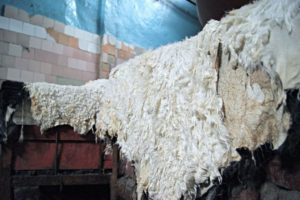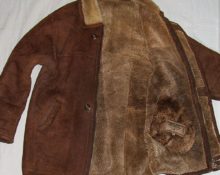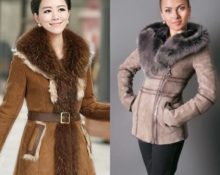Sheepskin coat is one of the popular types of winter clothing. Since ancient times, people have realized that animal skins are durable, wear-resistant and retain heat well.
Natural sheepskin coats
 The classic natural material for the production of sheepskin coats is sheep skin. These animals have high quality fur and skin. There are many breeds of sheep, and therefore types of material. The skins of young lambs are the most valuable.
The classic natural material for the production of sheepskin coats is sheep skin. These animals have high quality fur and skin. There are many breeds of sheep, and therefore types of material. The skins of young lambs are the most valuable.
Types of skins:
- Merino. It is distinguished by thick wool and small hair diameter. Sheepskin coats made from it are very warm. The disadvantage is the susceptibility to hair loss due to its small thickness.
- Merinillo. These are smaller skins than merino. The fur is soft and thin.
- Enterfino. Sheepskin coats of this type are less warm, but more wear-resistant.
- Tuscany. Produced specifically for sewing luxury clothing. It is distinguished by its special lightness and ability to retain heat well.
- Karakul (lamb skin of the Karakul breed).It is used for making fashion items, since this wool is rare. However, this type of skin is considered impractical because it has poor thermal conductivity. In extreme cold you can freeze in it.

- Goat. It is not often used for making sheepskin coats. The material is distinguished by a strong core, so the products are wear-resistant.
- Kangaroo. This is an exotic skin with very nice, soft, plush fur. Clothes are sewn with the fur at the top to show off all the beauty of brown fur. They also like to be tinted to resemble leopard and tiger.
- Tigrado. They are made from a special breed of lamb with curly curls of hair. The advantage is an exclusive appearance while maintaining quality and lightness.
Artificial sheepskin coats
 Modern artificial materials are sometimes not inferior in quality to natural ones. Of course, it all depends on the manufacturer. It is not difficult to distinguish faux fur from natural fur. Synthetic material is more shiny in appearance, but fur can be hard and not pleasant to the touch. Sheepskin coats may have a specific smell.
Modern artificial materials are sometimes not inferior in quality to natural ones. Of course, it all depends on the manufacturer. It is not difficult to distinguish faux fur from natural fur. Synthetic material is more shiny in appearance, but fur can be hard and not pleasant to the touch. Sheepskin coats may have a specific smell.
IMPORTANT. The undeniable advantages of artificial sheepskin coats are the variety of color options and reasonable price.
Processing options
 The skins are tanned. This is a method of treating skin with special substances. Thanks to this, they become less susceptible to environmental conditions. The type of impregnation used determines the color of the sheepskin coat.
The skins are tanned. This is a method of treating skin with special substances. Thanks to this, they become less susceptible to environmental conditions. The type of impregnation used determines the color of the sheepskin coat.
REFERENCE. This technology received its name thanks to oak, since the first tannins were prepared from acorns. They were collected from trees infected with the fungus.
The inner part of the skin (the inner part) becomes stronger and smoother. Often the flesh is processed in such a way that the resulting product fits on both sides.It all depends on the manufacturer's intentions. The fur is also processed to make it smoother and more beautiful. Only astrakhan fur is left in its original form. All other types of fur are cut and plucked. There are sheepskin coats with a special coating that resembles lamination. You can also use special sprays that repel dirt and water.
We hope that this article will be useful, will help you navigate the wide variety of materials for the production of sheepskin coats and allow you to make the right choice.



 0
0




